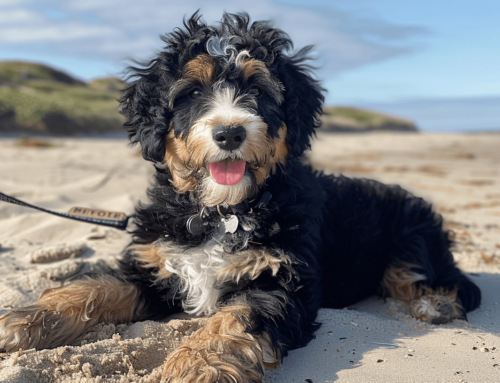Have you ever seen a dog with a beautiful, mottled grayish coat and wondered what breed it is?
It’s likely that it was the unique and amazing Merle Bernedoodle! This rare colored Doodle is gaining in popularity due to its rare coat colors and for a good reason.
In this blog post, we’ll explore everything you need to know about Merle Bernedoodles, from their distinct coat color and patterns to their charming personalities and essential health considerations to remember in merle dogs.
Table of Contents
Short Summary
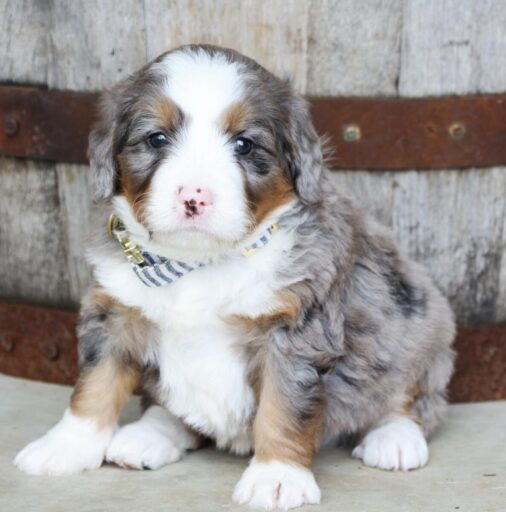
- Merle Bernedoodles are not considered a distinct breed of Bernedoodles. Instead, Merle is a coat color and pattern that varies in intensity and pattern from dog to dog.
- The Merle color and pattern can only be seen on the black base color of a Bernedoodle and not on any white or tan markings.
- When looking for Merle Bernedoodle breeders, it is important to find those who have a good understanding of the Merle gene due to the health effects associated with this color.
- If both parents carry this gene, it can lead to the birth of Double Merle Bernedoodles who may have insufficient pigment and could potentially experience serious health problems.
What is a Merle Bernedoodle?
A Merle Bernedoodle is a specific type of Bernedoodle dog, known for its unique coat pattern called “merle.” This pattern is not a color itself but a modification of the dog’s base coat color, creating a distinctive mottled or speckled appearance.
The merle gene dilutes the base color of the coat, resulting in patches of lighter color mixed with the original coat color. This effect is most commonly seen in dogs with black or brown base coats. In black-coated dogs, the merle pattern often gives a blueish appearance, leading to the term “blue merle.”
Understanding the Merle Gene
The merle pattern is caused by a genetic variation that affects the pigmentation of the dog’s coat. It’s important to note that merle is not just a coat color but a genetic pattern that can also influence other aspects of the dog’s appearance, including eye color and the coloring of the nose and paw pads.
For instance, the merle gene can modify the dark pigment in the eyes, occasionally changing dark eyes to blue or creating a mix of colors within the eye. Similarly, the nose and paw pads may show a mix of pink and black coloring.
Merle Bernedoodles can exhibit a range of appearances because the merle pattern can interact with other coat colors and patterns. While the most common merle patterns in Bernedoodles are blue merle, other variations can occur, depending on the dog’s genetic makeup. It’s also possible for a Bernedoodle to have a merle pattern combined with other coat patterns like brindle, although such combinations are rare.
The unique and varied appearance of Merle Bernedoodles makes them particularly appealing to many dog enthusiasts. However, it’s crucial for breeders to be responsible and knowledgeable about the genetics of merle patterning, as breeding two merle dogs can lead to health issues in their offspring.
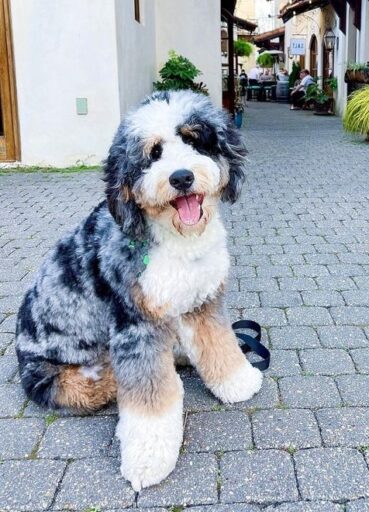
Origin of the Merle Bernedoodle
The fascinating part is that the Merle gene is not naturally present in either Bernese Mountain Dogs or Poodles. So how did this gene end up in purebred Poodles to produce Merle Bernedoodles?
This dilution gene is thought to have either occurred by a rare, naturally occurring mutation in the Poodle gene pool or was incorporated into one of the parental breeds through a careful breeding process involving another breed with the merle gene.
To create a Merle Bernedoodle, breeders typically mate a Merle Poodle with a non-Merle Bernese Mountain Dog or cross a Merle Bernedoodle with a non-Merle Bernedoodle, resulting in various patterns, including blue Merle Bernedoodles. One of the popular variations is the blue merle mini Bernedoodle, which has gained attention for its unique appearance.
Effects on Coat Colors and Patterns
The Merle gene creates a mottled merle pattern by diluting sections of the coat into lighter colors. The blue Merle tri-color Bernedoodle is the most common merle pattern observed in Bernedoodles. It features merle markings on the body while maintaining the beautiful white and tan points of the Bernese Mountain Dog.
The strikingly unique coat color and patterns of merle dogs are not the only captivating feature – many of them possess blue or partially blue eyes or even have two different eye colors (wall-eyed).
Such an arresting combination makes the Merle Bernedoodle very alluring.
Health Considerations for Merle Bernedoodles
While the Merle pattern gives Merle Bernedoodle their distinctive appearance, it is essential to be aware of the potential health issues associated with a double Merle dog.
Double merle Bernedoodles are produced if both parents carry the merle dilution gene, resulting in the offspring having excessive amounts of white hair and lacking pigment around their eyes and noses.
Due to the lack of pigment, Double merle dogs are predisposed to the following health issues:
- deafness
- vision problems
- sensitivity to light
- skin issues
However, these health issues can be prevented with proper breeding and only mating a merle dog with a non-merle dog.
By providing your Merle Bernedoodle with regular physical activity, a nutritionally balanced diet, and periodic veterinary examinations, you can ensure their well-being and overall health.
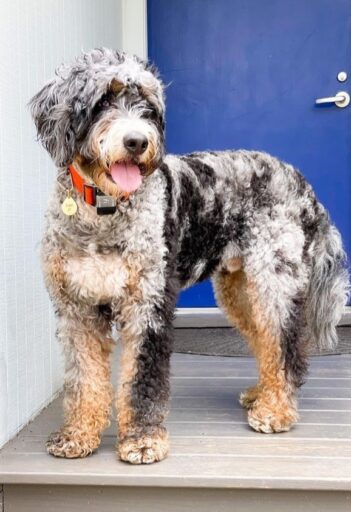
The Personality and Temperament of Merle Bernedoodles
Merle Bernedoodles are not just visually striking, they also have fantastic temperaments. These dogs possess:
- Intelligence
- Affection
- Loyalty
- Gentle and friendly nature
- Curious and playful demeanor
These qualities make them a perfect addition to any family, ensuring that there is never a dull moment when you have a Merle Bernedoodle around.
Their adaptability and ease of training make Merle Bernedoodles an ideal choice for those inexperienced with pet ownership. However, it’s crucial to provide them with proper socialization and training to ensure they become well-adjusted and well-behaved dogs.
Socialization and Training
Socialization and training are essential for Merle Bernedoodles to help them become accustomed to different environments and people while learning essential commands and behaviors.
Early socialization is especially important as it helps avert fear and aggression in the future. When it comes to training, positive reinforcement techniques are highly effective for Merle Bernedoodles.
Consistency in training is critical, as it helps reinforce desired behaviors and discourages undesired ones. By investing time and effort into socialization and training, you’ll be rewarded with a well-behaved, loving, and loyal companion.
Activity Levels and Exercise Requirements
Although Merle Bernedoodles have moderate activity levels, they require daily walks or jogs to keep them content and maintain their overall health. A well-exercised Merle Bernedoodle is a happier and healthier dog, so it’s essential to provide them with the physical activity they need.
Merle Bernedoodles will benefit from a variety of physical activities, such as:
- walking
- running
- swimming
- playing fetch
By providing your dog with a range of activities, you’ll help keep them engaged, happy, and healthy.
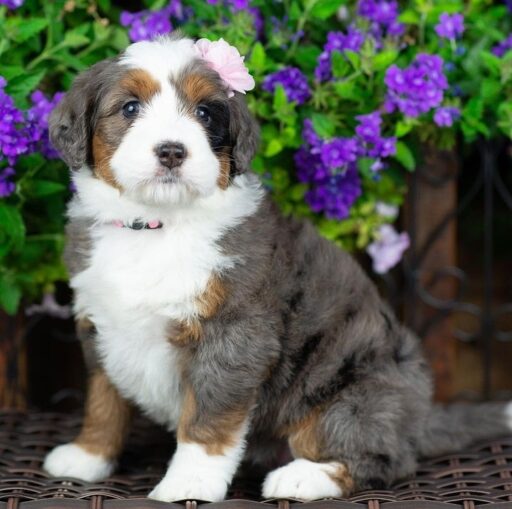
Caring for Your Merle Bernedoodle
In addition to their unique appearance, Merle Bernedoodles also require specific care and attention to keep them looking and feeling their best. This includes:
- Regular grooming
- Coat maintenance
- Exercise
- A balanced diet
Grooming and Coat Maintenance
Merle Bernedoodles have dense, wavy, or curly coats that require daily brushing and regular cleaning to prevent matting and tangles. It’s essential to bring them to a professional groomer every four to eight weeks for trimming to keep their coat in top condition.
Besides regular grooming, bathing your Merle Bernedoodle at least once every four to eight weeks helps maintain a clean and debris-free coat.
Don’t forget to pay attention to other grooming needs, such as trimming their nails, cleaning their ears, and checking their paw pads for any signs of injury or irritation.
By maintaining a regular grooming routine, you’ll help keep your Merle Bernedoodle looking and feeling their best.
Finding a Reputable Merle Bernedoodle Breeder
Now that you better understand the Merle Bernedoodle breed, you might consider adding one to your family. Finding a reputable breeder breeding Merle Bernedoodles is essential to ensure you get a healthy, well-bred puppy.
In this section, we’ll provide tips on locating a trustworthy breeder, evaluating their practices, and selecting the perfect Bernedoodle puppy for your family.
Evaluating Breeders
To find reputable Merle Bernedoodle breeders, you can follow these steps:
- Conduct online searches for breeders in your area.
- Read Google reviews and testimonials from previous customers.
- Ask for recommendations from friends, family, or acquaintances who have purchased a Bernedoodle.
- Seek advice from your veterinarian, as they may have knowledge of reputable breeders.
- When researching breeders, consider their experience and reputation in breeding Blue Merle Bernedoodles.
By following these steps, you can increase your chances of finding a reputable Merle Bernedoodle breeder.
When visiting a potential breeder’s location, pay attention to the cleanliness and orderliness of their breeding facilities and observe the health and socialization of their puppies.
Don’t hesitate to ask questions about the breeder’s experience with the Merle gene, their breeding techniques, and the health and temperament of the puppies.
A reputable breeder will be more than happy to address your concerns and provide the necessary information to help you make an informed decision.
Related Article: 15 Questions to Ask When Choosing a Bernedoodle Breeder
How Much Do Merle Bernedoodles Cost?
The cost for a Merle Bernedoodle is typically higher than other Bernedoodle coat colors due to the rarity and difficulty of breeding them. A well bred Merle Tri Bernedoodle can cost approximately $4000 – $5000 USD.
While the price may be higher, it’s essential to consider the unique qualities and characteristics that Merle Bernedoodles possess and the joy they can bring to your family.
Summary
In conclusion, the Merle Bernedoodles has a unique and captivating merle coat that perfectly combines a stunning appearance and delightful temperament.
By understanding their origin, coat patterns, health considerations, and grooming needs, you’ll be well-prepared to provide your Merle Bernedoodle with the love and care they require.
If you’re considering adding a Blue Merle Bernedoodle to your family, remember to research reputable breeders and select a puppy that fits your lifestyle!
